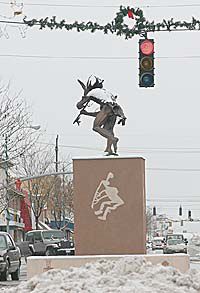| Traffic lights like this one hanging over Kokopelli on Price’s Main Street are common all across the United States. But one has to wonder how they got to be the way they are, and why the colors red, yellow and green for the lights? |
Why are traffic lights set up with red, yellow and green signals, and how did they come to mean what they do (go, stop and caution)?
Traffic lights have a long and complicated history, particularly if one examines their various forms throughout the world. In times past, various countries devised their own semifore controls, using different kinds of signals and lights. According to most sources the first traffic light was actually set up in 1868 in London, England to control street traffic near the British Houses of Parliament. The light used a system similar to the gas lamps that were used for railroad signals at the time, which used red and green lamps. At the time there was no way to automatically operate it, so it was changed by a lever at its base by a policeman. A little over a year after it was installed it exploded, injuring the man who was running it.
The German’s claim they were the first ones to install electric traffic lights in 1924 in Berlin. The lights were mounted on an octagonal tower which was controlled from a cab that sat on the top of the tower by a policeman, but only a few years later they were automated.
Interestingly enough the modern traffic light that is in use today was invented in Salt Lake City by a policeman named Lester Wire. It was still however only a red-green light. Within a couple of years another light appeared in Cleveland, Ohio which had the a similar red-green combination, but had a buzzer which signified a color change was coming up shortly. The first four way light with three colors was introduced to Detroit, Mich. in 1920.
Even before that however, the evolution of interconnecting traffic lights for flow came in Salt Lake where in 1917 a system was developed to control traffic at six intersections at once. This system was still manually controlled however.
By 1927 automated lights were appearing and began springing up all over the world.
But the forms many around the world took were very different from those found in America. For instance rather than using yellow as a warning for cars nearing a “stale” light intersection some places had a timer hanging near or on the light that showed the amount of time a light had left on it before it changed. In many countries the lights look very different from what they do in North America. Some have banks of lights that mean various things. Some use four colors with a green yellow meaning the yellow will soon come up. Others use a flashing green-yellow to tell people that the light is getting ready to go to solid yellow. Many lights around the world have various signals with them for pedestrians and warnings; many have various arrows. In actuality it could be a lot more complicated than it is today and before 1968 it was. That was the year a meeting in Vienna, Austria (called the Vienna Convention) set international standards for traffic signals, which has generally resulted in more uniform signals around the globe. However, there are still many differences and signals in some countries that don’t meet the standard.
As for the colors, apparently the electrical and railroad industry began using red and green to mean things many years before traffic lights, and the semifores were an outgrowth of that. It has been proven that colors affect peoples attitudes, and that red, in particular can make people ansey and inflame them, while green is more soothing. Yellow is considered warm. But red often meant danger to people in the past, and how that happened no one seems to know.
In modern America the traffic light is ubiquitous. It is common for many drivers to boldly ignore the signals and go their own way, running yellows and often even red lights. Many accidents result from this, with thousands of deaths being recorded from people running red lights.
How people observe lights is interesting, but no explanation for the way Americans treat traffic lights is better than a line from the movie Starman starring Jeff Bridges. In the movie Bridges is an alien being whose space ship is shot down over Wisconsin by the defense department and he takes on the identity of a dead man whose wife thinks he has miracously come back to life. He explains who he is and when she is in the process of driving him to Arizona to meet a mother ship to take him home he observes her reaction to traffic lights as the truth of the matter when he says, “I watched you very carefully. Red lights (mean) stop, green lights (mean) go and yellow lights (mean) go very fast.”
(Information for this article came from Wikipedia and Ask Yahoo).

